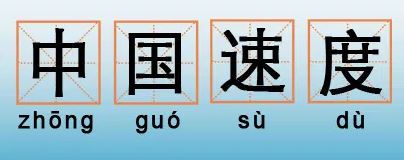
Linguists might call “China Speed” Chinglish, that is, a blend of Chinese and English incorporating some Chinese vocabulary or constructions. “Chinese speed” is more grammatically correct, and if you say “zhōngguó sùdù” in Chinese, you will get a praise from Chinese speakers for its originality. The phrase “China speed” is often used in Chinese media and by Chinese officials. It implies that Chinese people deliver results collectively at a remarkable speed, showcasing the efficiency and decisiveness of leadership.
Chinese people are proud of their China speed. As the world is watching China’s global influence grow, more of Chinglish like “China speed” will be introduced to the world. China is now on the path of sustainable development which is a forerunner to cutting greenhouse gas emissions. If China’s sustainable development sees positive results, and if the United States continues to withdraw from global leadership, China is expected to become a successful case study for many nations. Perhaps we will see more Chinglish during international experience sharing. We cannot learn the Chinese language at China speed, but we may learn about China with a glimpse of China’s achievement that was obtained at China speed.
Under one-party rule, leaders execute China speed much easier than in a multi-party government. China needs direct foreign investment to eradicate poverty and improve quality of life. So the economic reform kicked off forty years ago. To the Western media’s disappointment, Chinese people have more praise than grievances about the Communist leadership’s decision since 1978 to promote state-controlled capitalism. “The blistering pace of expansion” by China’s economic reform has impressed Chinese people and the world as “China speed.”
Chinese politicians like to link “China speed” to their resolution to deliver grand plans. Indeed, where else can we see a government like China’s that orchestrates collective efforts and builds in merely six days on an around-the-clock work schedule two Fangcang shelter hospitals in Wuhan, once the epicenter of the covid pandemic? Indeed, there is only one large Communist-ruled country with 1.4 billion people on the planet. It gives so much material for Democratic states to criticize. The faster China grows, the faster criticism comes at China. I call it the “China speed spillover effect.”
2020 marks the 40th anniversary of the establishment of three special economic zones (SEZ) in Guangdong province, China’s economic powerhouse and manufacturing hub. The most well-known one is Shenzhen which was transformed from a fishing village to a thriving metropolis within one generation. From 1979 to 2019, Shenzhen’s GDP rose at an annual growth rate of 21.6 percent to 2.69 trillion yuan (US$ 389 billion equivalent). With its per capita GDP skyrocketing from 606 yuan to 203,489 yuan, Shenzhen ranks as the third most expensive Chinese city in 2018, following Hong Kong and Shanghai. Adjacent to Hong Kong, Shenzhen has become the “Silicon Valley of China” with the world’s biggest tech companies and China’s second busiest port.
The other two SEZ in Guangdong are Zhuhai and Shantou. Together with Xiamen in neighboring Fujian province, the first four SEZ were created in 1980. About the same time, China enacted the draconian “One Child” policy that bestowed upon the generation of only children, including me, another moniker—the generation of post-economic reform. China Speed does not care about who you are but what you do for a collective outcome, for a team project with a shared goal. I grew up with China Speed and I witnessed how China Speed had changed China’s landscape and people’s livelihood. If you don’t like fast-paced lifestyle, China is not a place for you to reside. In 2020, the SEZ have grown with confidence and pride whereas I have long been forced out of my beloved Guangzhou, the capital city of Guangdong, due to its unaffordable housing. Living outside China, my learning of my birth country has not been reduced or stopped. Quite the opposite. The Western world talks more about China than its own domestic problems. The United States’ foreign policy has long targeted China as an opponent. China is the U.S. scapegoat for mishandling COVID-19. China is a business opportunity for the post-Brexit-with-no-deal U.K. to cling to. China’s Belt and Road Initiative (BRI) has freaked out democratic states opposing China’s geopolitical dominance. China’s cross-strait stance toward Taiwan and the Hong Kong national security law add fuel to an ideological war abroad between the pro-China camp and its opponents. China’s rapid change outpaces my writing about the country. My writing falls behind China speed.
The escalation of China-US tech war further accelerates China speed in technological development. With determination and perseverance, Chinese surveyors reached the summit of Mount Everest this May to remeasure its height. According to China’s measurement, the height of the world’s tallest peak is 8844.43 meters which is four meters less than Nepal’s calculations. If this achievement was completed by the U.S. or Canada or any allied countries, the world would have celebrated the result. But the expedition was made by the Chinese at China speed—roughly a week’s time. The world cast doubt and even amped up the “China threat” rhetoric. I note that when one is political, everything she sees is in the lens of politics. As a result, everything could be politicized. When one is racially biased, everything she sees is in the lens of racism. As a result, she stands on either polarity—whether she has the innate privilege or she is treated unfairly due to racial discrimination.
As I continue to marvel at China speed which is astonishingly fast and remarkably in sync, I worry about the US-China relationship. In one way or another, both countries need to work out a co-existent solution in the ever technologically-integrated world. Despite Chinese businesses chasing profit and efficiency like those in the U.S., a healthy mechanism of quality control is greatly needed among China Inc. China speed in business does not necessarily boost the image of Chinese shoddy goods. There is still room for China to maintain speed and quality. In the IT sector, the chips to smartphones are like a brain to human. China speed explains why it is so hard for ARM, a British company responsible for the architecture of majority of mobile processors today, or metaphorically, the rulebook for the brain of smartphones, to compete with Chinese phone makers. The breakneck pace of change and innovation in China’s mobile market at China speed sustains the cash flow of research and development in tech companies. The typical time to go from the raw design to a full retail product is at least a year but Huawei chopped a full third off the turnaround time. Chinese consumers upgrade their smartphones at a pace almost like changing socks. My personal experience is my Chinese phone is always outdated when I revisit the country.
Whether it is China speed or American speed, let us hope the story of The Tortoise and the Hare will shed light on the truth that success requires effort. The world’s two biggest economies should run toward the finishing line of a shared goal together. Stronger together.
